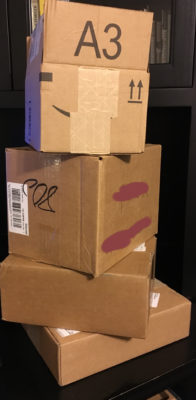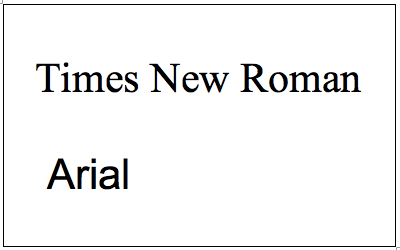and what NOT to send
In my previous WAG Blog, I gave tips on how to find the right agent for your book. Now I’ll focus on what material you should send to an agent or a publisher — and what you should not send. Do you box up your whole book and send it off to multiple people?
 Maybe twenty years ago you did, but not now.
Maybe twenty years ago you did, but not now.
First, you’ll create a list of potential agents. I suggest you list 30 to 50. To be on the safe side, send your materials to only 5 to 10 agents at a time, so you can respond appropriately, Remember that in this day and age, you usually send a query letter, whether you send other material or not, and if the agent is not interested you don’t get a response.
As stated on the Agent Query website: “Actually, the truth is that these writers are getting responses. That cricket chirping silence? Yeah, that? Chirping crickets = rejection from the agents. No response required because they ain’t interested.”
Don’t take it personally if you don’t hear from them. And DON’T contact them to ask if they got it. Move on.
Go to the websites of the agents or publishers. Find out what they want. Most of the time, all they want is a letter describing your material. But sometimes they want the first chapter, or the first 50 pages. Follow instructions. This may sound like common sense, but the biggest complaint agents have is that writers don’t heed their specific requests for material.
What should you put in a query letter? The query letter is almost universally a requirement – a one-page – wait, let me repeat that – a one-page letter that describes your work. In many cases, that is all the agent wants. Here are the basic elements of a query letter:
-
-
- Why are you contacting that specific agent? This is where you show you did your homework —you know this particular agent is interested in the type of book you wrote.
- Describe the book. Make it punchy, interesting, quick. Show, don’t tell. What will catch the readers’ attention? Take a look at the descriptions of Amazon’s top sellers or at the New York Times Best Seller list for ideas about how to describe your book.
 Put in your word count – and know the typical word count for books. A book that is 150,000 words is probably too long for most publishers. A book that is 20,000 words is probably too short for most adult novels. Writers Digest has an excellent article on word count.
Put in your word count – and know the typical word count for books. A book that is 150,000 words is probably too long for most publishers. A book that is 20,000 words is probably too short for most adult novels. Writers Digest has an excellent article on word count.- Who is your audience? Do you know what YA is (Young Adult), NA (New Adult)? Are you familiar with adult contemporary fiction? Do you know the difference between Sci Fi and Fantasy? You need to describe accurately the genre of your book and who would enjoy reading it. The California Department of Education has an excellent list of genres you might find helpful.
- Who are you and why are you the perfect person to write this book? BRIEFLY describe your writing experience. If you’ve published other books, articles, etc., mention those. If you’re in a writers group, say, the Writers Alliance of Gainesville for example, you can mention that. If you’re sending non-fiction – say a book about medicine – are you a doctor? Are you a musician writing about music? Mention that. Don’t brag – just state the facts.
- If you’re a new writer, be sure to tell the agent that your book is done. They don’t want to see a novel by an amateur who has only completed the first 50 pages but has a wonderful idea for the rest of the book, really. Uh uh … Nope.
Spend some time on this letter and have fellow writers take a look at it. Remember, this may be the only thing the agent or publisher sees. If you can’t write a decent one-page letter, why would they ever take a look at your actual book?
- What about manuscript pages? Many agents will request a specific number of pages of the manuscript in addition to the query letter. Again, do your research. Do they want the first chapter? First fifty pages? Don’t send something different from the request. Don’t send more than requested. Here are some tips about those pages:
-
- If the first chapter is requested, does your story start in the right place? Lots of times, writers meander until they find their voice. Make sure your chapter is the very best starting point for your story, one that will pull readers in.
- Professional manuscripts are usually double-spaced, in a typical font such as Times New Roman or Ariel,
 font-size 12. They usually have one-inch margins all the way around. Don’t play games. If the agent wants ten pages, don’t make your font size 8 so you can get more stuff in. Don’t make your margins a quarter inch so you can squeeze more pages in. Look and act like the professional writer you want your agent to see.
font-size 12. They usually have one-inch margins all the way around. Don’t play games. If the agent wants ten pages, don’t make your font size 8 so you can get more stuff in. Don’t make your margins a quarter inch so you can squeeze more pages in. Look and act like the professional writer you want your agent to see. - Polish, polish, polish. Make sure your material reads perfectly. Make sure it holds the interest of other readers – try it out on family and friends. Does it make them want to read more?
- If the agent requests the entire manuscript, Jackpot! But you’d better be ready. Don’t dare tell an agent you’re not quite done, and you’ll have it to them in a month or so. You weren’t supposed to contact the agent till you were ready, remember?
- How do I write a synopsis?
- If an agent requests a synopsis of your book, what will you send them? The synopsis describes your story from beginning to end.
- That being said, don’t get crazy. The agent doesn’t need to know everything that happens in the story. If your synopsis is 20 pages, you’re sending too much.
- Most published authors and agents recommend a one-page synopsis. That can be tricky if you have 50 chapters. Obviously, you’re going to have to outline your work, skipping multiple sections. But that’s okay – decide which details are crucial to the storyline and include those.

Jane Friedman - According to author/instructor/super-blogger Jane Friedman:
“First, you need to tell the story of what characters we’ll care about, which includes the protagonist. Generally, you’ll write the synopsis with your protagonist as the focus, and show what’s at stake for her. Second, we need a clear idea of the core conflict for the protagonist, what’s driving that conflict, and how the protagonist succeeds or fails in dealing with that conflict. Finally, we need to understand how that conflict is resolved and how the protagonist’s situation, both internally and externally, has changed.”
- What format should you use? Personally, I like bulleted points, descriptions of each section of the book. Some people prefer to use plain paragraphs. Others number the synopsis by chapter – again, if you have 50 chapters, don’t do this! An excellent example of a synopsis is available on the web site Pub(lishing) Crawl. Using Star Wars as an example, they flesh out a perfect synopsis you can use as a sample.
- Avoid the usual issues all writers should avoid – mistakes, repetition, too much explanation. Again, if you can’t describe your book, why would an agent want it?
-
Remember, do your research. Send exactly what your agent requests. If they want one page, send one page. If they want the first five chapters, send the first five chapters. If they want a query letter posted inside an email, not as an attachment, send it that way.
 You might have the golden opportunity to work with this person in the future to sell your book—don’t start out ignoring their advice. After your masterpiece is accepted, you can negotiate. But if you start out ignoring their requests, no one will want to work with you. Best of luck in your search for publishing gold!
You might have the golden opportunity to work with this person in the future to sell your book—don’t start out ignoring their advice. After your masterpiece is accepted, you can negotiate. But if you start out ignoring their requests, no one will want to work with you. Best of luck in your search for publishing gold!

Joan Carter
What a great guide to the submission process! Just reading it, I feel like a winner.
Connie Morrison
Chirping crickets? Yes, I hear them. Thanks for sharing all this knowledge. Now, I guess I need to get busy!
Mary Bast
Thanks Wendy. Very well done and thorough. I’ve shared on Bacopa’s Facebook and Twitter pages.
Patsy Murray
I’m a long way from submitting, and may never, but if I do, I’m saving this article. Very helpful. Thanks, Wendy.
Ann-Marie Magné
Great blog post, Wendy. Full of helpful info. My favorite: “If you can’t write a decent one-page letter, why would they ever take a look at your actual book?”